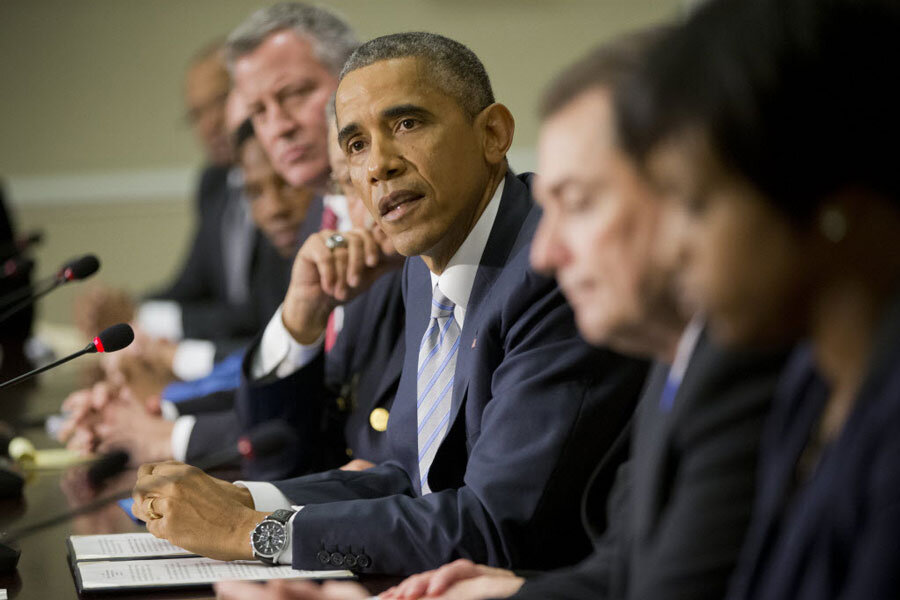Ferguson day at the White House: What did Obama accomplish?
Loading...
| Washington
President Obama focused Monday on the aftermath of unrest in Ferguson, Mo., meeting in succession with his Cabinet, young civil rights leaders, and stakeholders involved in strengthening community policing.
At issue is rising mistrust between law enforcement and minorities, particularly acute after a grand jury decided last week not to indict the policeman who shot and killed an unarmed black teenager in Ferguson last August. The decision sparked new violence in Ferguson and protests around the country.
“This is not a problem simply of Ferguson, Missouri. This is a problem that is national,” Mr. Obama said after a meeting with elected officials, community and faith leaders, and law enforcement officials.
“It is a solvable problem, but it is one that unfortunately spikes after one of them and then fades into the background until something else happens,” Obama continued. “What we need is a sustained conversation in which, in each region of the country, people are talking about this honestly and then can move forward in a constructive fashion.”
Attorney General Eric Holder was in Atlanta Monday evening to discuss race relations and policing in the aftermath of the Ferguson decision.
Earlier in the day, the White House announced measures aimed at strengthening community policing, including a request for funds to provide 50,000 “body-worn cameras” to police officers. The measures fell into three broad categories:
New standards for acquisition and use of excess military equipment by local law enforcement agencies.
After a three-month review of the programs, the Obama administration determined that the vast majority of transferred equipment is “fairly routine – office furniture, computers and other technological equipment, personal protective equipment, and basic firearms,” according to a White House report. Only 4 percent are categorized as “controlled property,” such as high-powered weapons and tactical vehicles.
But the report found a “lack of consistency” in how federal programs are structured, implemented, and audited. Obama instructed his staff to draft an executive order calling for the relevant agencies to develop recommendations for improvements within 120 days.
Task force on 21st century policing.
The task force will build on research being conducted by the Department of Justice’s Community Oriented Policing Services (COPS) Office, and will examine “how to promote effective crime reduction while building public trust,” the White House reports. The task force will be led by Philadelphia Police Commissioner Charles Ramsey and Laurie Robinson, a professor of criminology at George Mason University. The task force will report back with recommendations in 90 days.
Community policing initiative.
The president proposes a $263 million three-year program that would include funding for up to 50,000 body-worn cameras, expand training for local law enforcement and community-police engagement, and boost federal support for police department reform. The cost of the cameras is pegged at $75 million, and would require a 50 percent match by local law enforcement.
Officials believe body cameras can serve as a protection to both law enforcement and citizens when there are disputes over interactions, as was the case in Ferguson when officer Darren Wilson fatally shot Michael Brown on Aug. 9. The White House has begun discussing the funding request with Congress, a senior administration official told reporters.
Civil rights activists applauded the steps, but said they’re only a start.
“Today’s announcement marks a significant incremental step forward in addressing the lack of safeguards that contributed to the death of Michael Brown,” said Wade Henderson, president and CEO of the Leadership Conference on Civil and Human Rights, in a statement.
“The initial investments in body-worn cameras and community policing, the task force to study best practices in 21st century community policing, and greater standardization for how police can acquire military equipment are important down payments on the systemic reforms needed to address this national crisis.”







